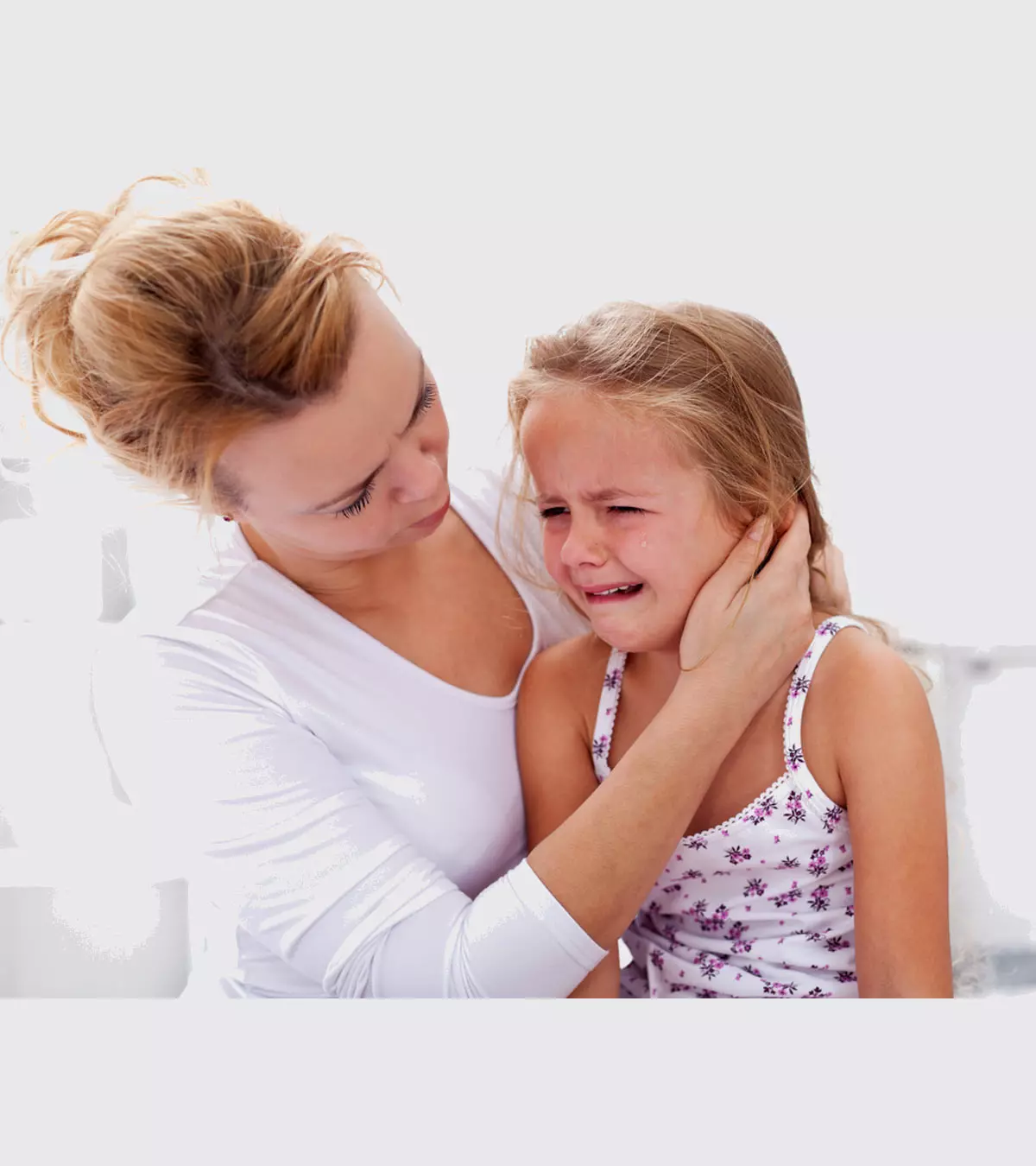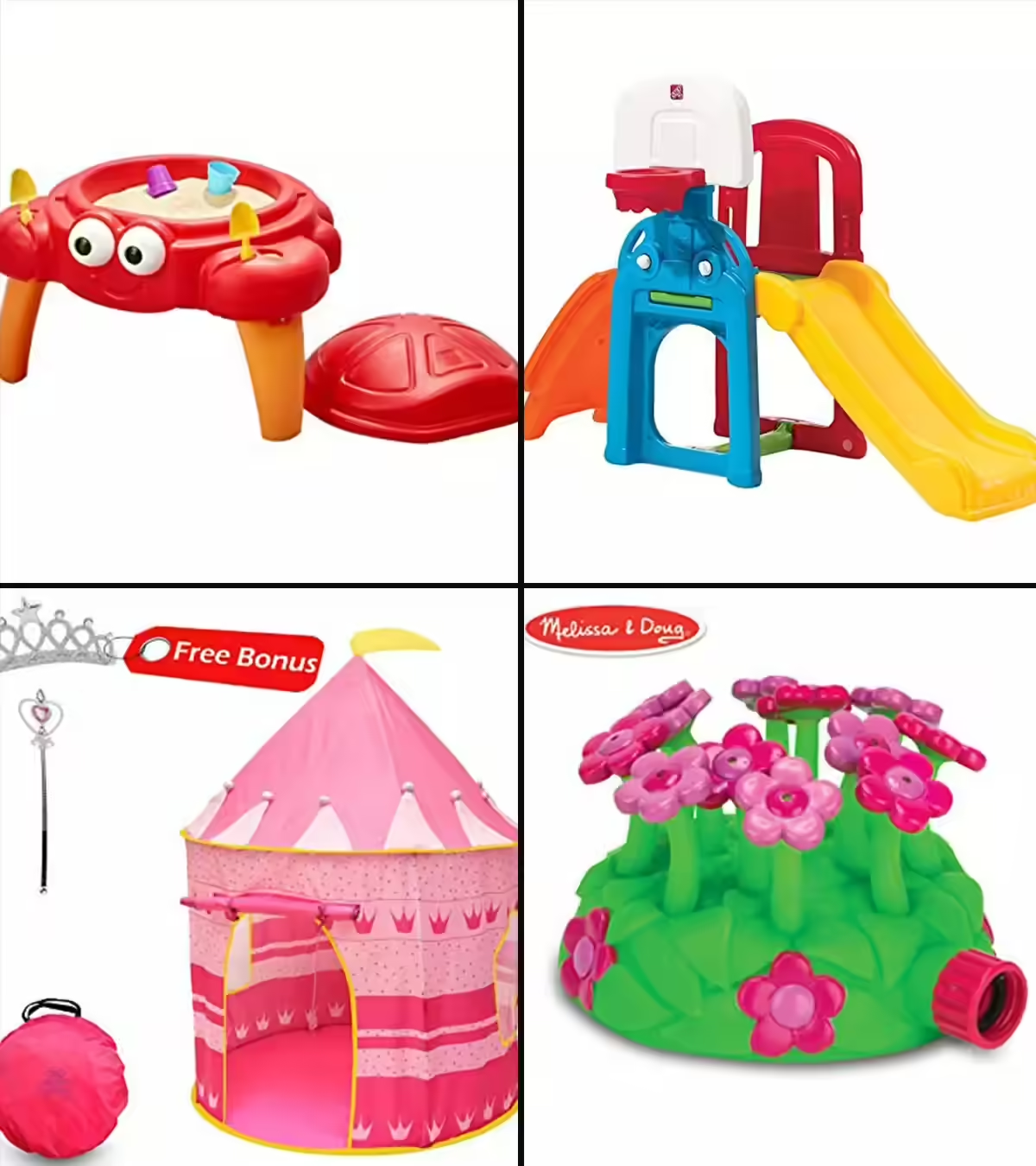

Shutterstock
Your heart may melt when you see your kid crying, which is a natural emotional response for babies and young children to difficult situations (1). They may cry to express various emotions, such as discomfort, confusion, anger, or fear. Since they cannot verbally express their feelings, they may even cry when they cannot cope with certain situations.
As a parent, you may find it difficult to manage a child who has frequent meltdowns, especially when you are unaware of the reason behind the tears. However, with your guidance and support, your child can learn to manage their emotions under stress and verbalize their needs.
Read this article to learn about some common reasons children cry and how to manage a crying child.
Causes Of Crying In Children
Excessive crying in children can be attributed to a medical disorder less than five percent of the time. Thus, crying in children may not be a cause for worry every time (1).
The following are some commonly observed reasons for crying in children.
1. Hunger
Just like in adults, children’s blood sugar levels drop when they have not eaten for a prolonged period. Low blood sugar or glucose levels can induce hormones such as cortisol (stress hormone) and adrenaline (the hormone responsible for inducing the fight or flight response).
The hormonal changes can cause your child to become “hangry”- a combination of hunger and anger and cause problems with regulating emotions (2). Engaging them in fun activities can distract them and make them forget about their hunger. If you notice a meltdown approaching and it is mealtime, offer them some healthy snacks.
2. Pain or discomfort
At times, children may convey to you that they are in pain but fail to locate the source of the pain precisely. In addition, they might be overwhelmed by the pain that they would continue crying and not help you understand the source or site of the pain.
Older children may also cry from the anticipation of pain. For example, a child might cry in the waiting room at the doctor’s office in anticipation of the pain they would feel from the injection.
Extreme heat, itchy clothes, a cloth label, hair tourniquet, etc., might also make children uncomfortable, leading to crying, especially in younger children.
3. Tiredness
Inability to maintain eye contact, rubbing of eyes, losing interest in activities, yawning, irritability, etc., indicate that the child needs rest. Crying might suggest that they are overly exhausted. Moreover, an overly tired child may find it difficult to fall asleep, further leading to more crying.
4. Over stimulation
Too much noise, too many people, visual effects, etc., may hyper-stimulate the child. Thus, they may not be able to handle or process so much information and begin to cry. They might also hide behind you or corner themselves to avoid the stimulation.
A very hectic schedule at school and extracurricular activities can also cause anger and fatigue and result in a meltdown.
5. Need for attention
At times, children cry to seek attention from their parents. If you have ruled out the other more probable causes, such as hunger, sleep, and fatigue, you may try spending quality time with them and focusing all your attention on them.
6. Separation anxiety
All children feel some anxiety, and it is a normal part of growing up. Separation anxiety is seen in many babies aged between 18 months and three years. But sometimes, the symptoms, of which crying is one, may appear when they are in their third or fourth grade (3).
7. Self-conscious emotions
Children begin to develop emotions such as guilt, embarrassment, and shame by two to three years (4). They might begin to feel remorse when they intentionally or unintentionally hurt a friend or family member. They might also begin to develop empathy for other people or animals and may cry when hurt. This surge of self-conscious emotions can cause emotional meltdowns.
8. Fear
These cries may be abrupt and loud. They may cry due to loud noises such as the barking of dogs, lightning, fears of strangers, etc (5). Listening to a scary story, seeing a bad dream, fear of losing loved ones after getting familiar with the concept of death, or nightmares may also cause them to cry.
9. Disappointment
Not finding a toy, getting the wrong flavor of yogurt, losing a piece of their Lego set, not winning a game, etc., are some small things that are huge problems in a child’s world. Such upsets and disappointments might cause them to have an emotional breakdown in no time (6).
How To Get A Child To Stop Crying?
The first step in managing or stopping a child from crying is to understand the reason behind the crying. Once you determine the reason behind those tears, you can help your child understand how to manage their emotions.
While such frequent meltdowns may test a parent’s patience, they need to maintain their composure to help the child learn how to channelize their emotions well.
Donna Volpitta, Ed.D. and a New York-based mental health educator, states, “Crying is a way for our brains to rebalance neuro chemicals. In response to stress and threat, our brains release neuro chemicals such as cortisol and adrenaline in order to prepare us for fight-flight and freeze. Crying is one way to rebalance those neuro chemicals. It is best to support children as they are crying, wait for them to be ready to talk, and then talk about some ways to recognize the stress build-up and coping strategies that can help.”
The following tips might help you manage your crying child well.
1. Maintain your calm
Your own stress can make things much worse; and therefore, maintain your cool. Your composure will help them regain their calm too. Seeing you all anxious or conscious about their behavior can worsen their reaction.
2. Watch your words
Do not use words or phrases that would make the child feel that you are invalidating their emotions. Avoid using phrases such as “It is not a big deal,” “Oh come on, it isn’t something to be so upset about,” or “Are you a baby? Why are you crying like a baby?” Respect their emotions, and be thoughtful of what you say.
Instead, you can instill positivity in them by using phrases such as, “I know you are feeling sad, and I am sorry that you have to feel this way,” “Would you tell me about your feelings?” “Can you express what you feel through words so I can help you?” or “Let us both take a few deep breaths. We can then discuss how to solve this problem.”
Dismissing their emotions is not a solution. Instead, acknowledge their feelings and encourage them to learn how to face these distressing moments better (7).
3. Remember that they are just children
Keep in mind that they are still young children and do not understand things as rationally as you would. So, listen to them, assure them that you understand how they feel, and help them find a way to solve their problems.
4. Give them some space
At times, immediate intervention can cause more harm than good. It might be a good idea to give your child a few minutes to vent. This can help the child understand that it is okay to cry and enable you to raise an emotionally stable child.
5. Stick to the schedules and routines
Overtired children can have meltdowns easily. Stick to their nap and sleep schedules to help avoid severe emotional meltdowns. It is also essential to maintain their food schedules because hungry children may not be able to regulate their emotions. If you are traveling, make sure you carry some snacks for them and ensure adequate breaks to avoid fatigue.
6. Maintain a neutral stand
Validate their emotions and disappointments but do not give in to their unreasonable demands. Their tantrums must not alter your behavior or response. Also, do not agree to their unreasonable demands if they cry.
Frequently Asked Questions
1. Should I punish my child for crying?
You should discipline your child’s behavior and not emotions. Thus, if your child is crying, focus your energies on understanding the cause and finding its resolution rather than punishing the child. Experts advise that parents should focus on teaching their children good behavior rather than punishing the bad behavior (8). So, if your child is having frequent meltdowns, train them on the ways to regulate their emotions.
2. What to say instead of “stop crying?”
Since crying is a way children express their emotions, telling them to stop crying isn’t right. “ I see how upset you are,” “I know this is hard,” “It’s ok to be sad,” and “Tell me what is making you feel sad or cry” are some phrases you can use to reassure your child that no matter how bad things are, you have got their back.
3. Why shouldn’t I tell my child to stop crying?
Crying helps a child vent out their feelings and express their emotions. Asking a child to stop crying can restrict their emotions and can also rob them of their chance to learn emotional self-regulation.
Watching their kid crying is difficult for any parent, especially when you cannot figure out the reason behind their tears. They may cry for several reasons, including to draw your attention to satisfying their basic needs or to express emotions such as fear and disappointment. But, no matter the reason, your reaction to the situation is what counts. So remember to keep your cool and avoid immediate intervention. Also, assure them it is alright to cry, and you are there for them. In this manner, you can prevent frequent meltdowns and teach them to express their emotions effectively.
Key Pointers
- Excessive crying in children is related to medical disorders in only 5% of the cases.
- The most common causes for children to cry are hunger, separation anxiety, pain, overstimulation, etc.
- To encourage a child to stop crying, understand the reason behind the behavior, stay calm, and remember that they are still young.
- Scroll through the article to learn more reasons children cry and ways to help them.
References
- Crying
https://www.msdmanuals.com/home/children-s-health-issues/symptoms-in-infants-and-children/crying?ruleredirectid=743 - Is Being ‘Hangry’ Really a Thing ― or Just an Excuse?
https://health.clevelandclinic.org/is-being-hangry-really-a-thing-or-just-an-excuse - Separation Anxiety Disorder in Children
https://www.stanfordchildrens.org/en/topic/default?id=separation-anxiety-disorder-in-children-90-P02582 - Joan Luby et al. (2011). Shame and guilt in preschool depression: evidence for elevations in self-conscious emotions in depression as early as age 3. DOI:
https://www.ncbi.nlm.nih.gov/pmc/articles/PMC3184301/ - Crying Age 3 and Younger
https://www.healthlinkbc.ca/search?kw=health+topics+crybb - Crying Over Little Things
https://www.chop.edu/centers-programs/executive-function-consultation-education-and-skills-excel-clinic/crying-over-little-things - What NOT to Do When Your Child Is Having a Tantrum
https://childmind.org/article/what-not-to-do-when-your-child-is-having-a-tantrum/ - What’s the Best Way to Discipline My Child?
https://www.healthychildren.org/English/family-life/family-dynamics/communication-discipline/Pages/Disciplining-Your-Child.aspx
Community Experiences
Join the conversation and become a part of our nurturing community! Share your stories, experiences, and insights to connect with fellow parents.
Read full bio of Dr. Anuradha Bansal
Read full bio of Dr. Ritika Shah














